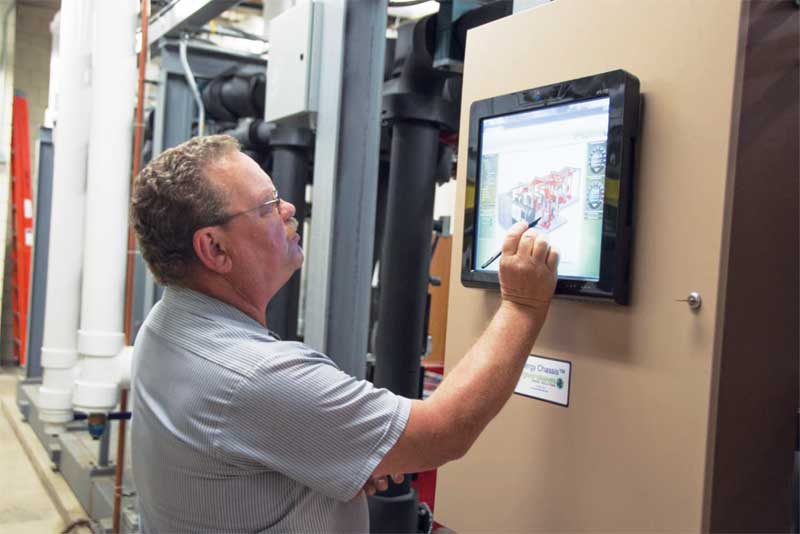
by Thomas Rice
As consulting engineers continually specify more sustainable HVAC technologies, they must ensure their designs comply with a variety of standards. Of course, when possible, it is even better to go far beyond those baseline requirements. In this respect, the University of Findlay’s $11 million Davis Building is a role model for future commercial mechanical technology, as it is an example of a facility design exceeding minimum requirements of several American Society of Heating, Refrigerating, and Air-conditioning Engineers (ASHRAE) standards.
The 3900-m2 (42,000-sf) building, south of Toledo, Ohio, is based on a geothermal concept, but it far surpasses conventional system designs that employ heat pumps or unitary air-handling units (AHUs). Instead, the building employs chilled beams and dedicated outdoor air systems (DOAS) for energy recovery and outdoor air.
The science facility, which consists of 19 labs, four classrooms, a 112-seat lecture hall, computer lab, and 15 faculty offices, recently won an ASHRAE Technology Award in the Educational Facilities−New Construction category. More importantly, the HVAC system is saving 57 percent more energy, which translates annually into a $59,000 energy savings and $7500 in reduced maintenance. Its energy use intensity (EUI) is only 64 kBtu/sf.1
The HVAC system was designed by Stephen Hamstra, PE, LEED AP, an ASHRAE-certified High Performance Building Design Professional (HBDP) of consulting engineering firm, Greensleeves. RCM Architects was the building architect.
Geothermal and chilled beams
Typical geothermal systems deliver water pre-conditioned by inherent ground temperatures to forced-air systems such as heat pumps or air-handling units (AHUs). Fan energy is used to distribute air across these systems’ coils.
Instead of conventional design using heat pumps and air-handlers, the University of Findlay project used ceiling-mounted chilled beams, which are fin-and-tube heat exchangers distributed strategically throughout a room. Therefore, the geothermal water is pumped to chilled beams, which condition the space via convection. Warmer air rises up to the chilled beams and then falls downward as it cools. This results in a less drafty, more evenly tempered space, but most importantly, chilled beams boast fan energy reductions of up to 60 percent versus heat pumps and air-handlers.

A central outdoor air system (i.e. DOAS) typically distributed small amounts of dehumidified outdoor air to the chilled beams to eliminate condensation on chilled beams, maintain comfortable room relative humidity levels and comply with ASHRAE 62, Outdoor Air Ventilation Requirements−Institutional Facilities. In comparison with a typical heat pump or AHU forced air system, considerably less air is distributed to the chilled beams at significant lower fan energy costs.
Geothermal HVAC systems are an ideal application for chilled beams. Utilization of higher-temperature chilled water (i.e. 14 C [57 to 58 F]) allows for a greater capacity of cooling with less mechanical energy. Further, the geothermal borefield is not warmed as quickly because the amount of rejected energy is less per gallon of water cooled.
Chilled beams improve the indoor environmental air quality through increased ventilation effectiveness, room quietness and good room air distribution. The geothermal side helps the exterior environment by reducing the amount of evaporative water consumed and carbon dioxide (CO2) emissions. The combination of the two building technologies makes it possible to achieve a low kBtu/square foot energy consumption.
Project specifics
For the Findlay project, the geothermal system supplies 14- to 17-C (58- to 62-F) closed-circuit ground-source water to ceiling-mounted, active chilled beams for handling 70 to
80 percent of the sensible load. Chilled beams reduce fan energy by up to 50 percent versus conventional air-handling technologies, so they comply and typically surpass the requirements of ASHRAE 90.1, Energy Standard for Buildings, Except Low-Rise Residential Buildings.
Each chilled beam requires only 2.8 to 3.5 m3/minute (100 to 125 cfm) from the project’s 538-m3/minute (19,000-cfm) DOAS to prevent condensation. Additionally, chilled beams helped ASHRAE 90.1 compliance, because they reduced the required air-conditioning tonnage by approximately 25 percent versus a geothermal/heat pump design.
ASHRAE 62.1, Ventilation for Acceptable Indoor Air Quality, defines requirements for ventilation, air-cleaning, design, installation, commissioning, operations, and maintenance. It specifies minimum ventilation rates and other measurements intended to provide indoor air quality (IAQ) acceptable to human occupancy and that minimize adverse health effects. DOAS can be integral to ASHRAE 62.1 in that they typically have high MERV filtration (i.e. minimum efficiency reporting value) and specially sloped drain pans to minimize condensation accumulation that could potentially introduce mold to the supply airstream.




